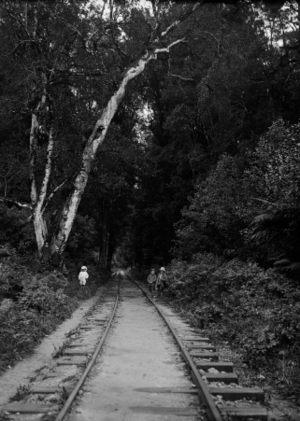Mountain Rimu Timber Company
| Mountain Rimu Timber Company | |||||||||||||||||
|---|---|---|---|---|---|---|---|---|---|---|---|---|---|---|---|---|---|
|
Eight-axle Price steam locomotive from
| |||||||||||||||||
|
Forest railway in the Mamaku bush, 1923
| |||||||||||||||||
| Gauge : | 1067 mm ( cape track ) | ||||||||||||||||
|
|||||||||||||||||
The Mountain Rimu Timber Company Limited owned and operated a forest railway with steel rails in Mamaku south of the Kaimai Range in Rotorua in the Bay of Plenty region of the North Island of New Zealand . The forest railway with a gauge of 3½ feet (1067 mm) was in operation from about 1898 to at least 1935.
history
The Mountain Rimu Timber Company was founded on January 24, 1898 to buy the Kusabs brothers sawmills. She owned 1,600 hectares (4,000 acres ) of prime bushland. The sawmills and office were about 3.5 mi (6 km) from the NZR train station, to which they were connected by the forest railway. The sawmill was powered by a 25 hp stationary steam engine. There was a complete sawing and planing system that could process 3,000 cubic meters of saw and sawn timber per day. The timber was marketed throughout the Auckland district and much of it was exported to Australia. A large amount of cut firewood was sold in Rotorua.
The New Zealand Railway Authority concluded in 1924-26 that it would be beneficial to have your own lumber and bought the sawmill. However, eight to ten years later, on August 31, 1934, the state sawmill was closed and its employees laid off. The reason for this was that wood could be obtained more cheaply on the free market than from Mamaku. The railroad's board of directors had published tenders for wood and found it could be obtained at a much lower price than at its own sawmill in Mamaku.
At that time, there were still 8 million cubic meters of wood in the bush. There was a forest railway with steel rails straight into the bush and there were facilities that no other mill had. The plant was located near the railway line at the top of the Mamaku spur, with the easiest transport conditions. There were two steam winches for logging , 2 mi (3 km) wire rope, two locomotives, one of which was only recently put into service there, and twenty-six cabins that generated income of £ 500 a year in rent . Nevertheless, the mill was closed.
Locomotives
- Eight-axle steam locomotive by A. & G. Price , type D, built in 1910, 1910–1916 for the Mountain Rimu Timber Co. Mamaku
- Eight-axle steam locomotive by A. & G. Price, built in 1913, 0-4-4-4-4-0 , 1913–1916 for Mountain Rimu Timber Co., Mamaku
Web links
Individual evidence
- ↑ The Mamaku Sawmill. Opening ceremony. In: New Zealand Herald. June 23, 1898, p. 5.
- ↑ Mamaku. In: The Cyclopedia of New Zealand (Auckland Provincial District). Cyclopedia Company Limited, Limited, Christchurch 1902.
- ^ A b Parliamentary Debates, New Zealand Parliament (August 30, 1934). Volume 239, 1935, pp. 548-549 ( books.google.de ).
- ^ Parliamentary Debates, New Zealand Parliament (July 12, 1934). 1934, p. 386 ( books.google.de ).
- ^ The Locomotive Owners: A & G Price Ltd., Thames.






